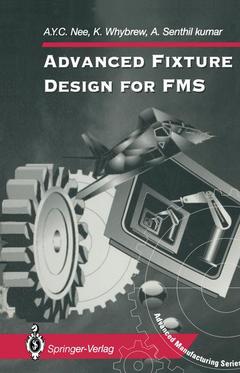Description
Advanced Fixture Design for FMS, Softcover reprint of the original 1st ed. 1995
Advanced Manufacturing Series
Language: English
Subject for Advanced Fixture Design for FMS:
Publication date: 11-2011
204 p. · 15.5x23.5 cm · Paperback
204 p. · 15.5x23.5 cm · Paperback
Description
/li>Contents
/li>
Fixtures are crucial to new manufacturing techniques and largely dictate the level of flexibility a manufacturing system can achieve. Advanced Fixture Design for FMS provides a systematic basis for the selection and design of fixturing systems. It gives a review of the current state of the art of flexible and reconfigurable fixturing systems. Recent developments in design methodology using CAD are analysed in depth. Fixture design is seen as an inseparable part of process planning. The primary objective of a fixture system is to ensure that the part being manufactured can be made consistently within the tolerance specified in the design. A new method of tolerance analysis is used to check the suitability of location surfaces and the sequence of operations and is explained in detail.
1 Fixtures and flexible manufacturing systems.- 1.1 Introduction.- 1.2 AMT and fixtures.- 1.3 Fixture strategies for FMS.- 1.4 References.- 2 Fixture design fundamentals.- 2.1 Introduction.- 2.2 Definitions.- 2.3 Fixture design.- 2.4 Design outcomes.- 2.5 Design criteria.- 2.6 Design techniques.- 2.7 Conclusions.- 2.8 References.- 3 Tolerance control and location surfaces.- 3.1 Manufacturing tolerance stacks.- 3.2 Tolerance charts.- 3.3 A new tolerance charting algorithm.- 3.4 CAPPFD.- 3.5 Conclusions.- 3.6 References.- 4 Flexible fixture systems.- 4.1 Introduction.- 4.2 Evaluation of fixture systems.- 4.3 Flexible fixturing.- 4.4 Conclusions.- 4.5 References.- 5 Computer-aided fixture design.- 5.1 Computer-aided design of fixtures.- 5.2 Approaches in fixture design.- 5.3 Fixture design techniques.- 5.4 Fixture design systems.- 5.5 A variant fixture design system using GT.- 5.6 A generative fixture design system using an expert system.- 5.7 References.- 6 Analysis methods for workpiece distortion and deflection.- 6.1 Introduction.- 6.2 Clamping devices.- 6.3 Machining forces, force models for milling and drilling.- 6.4 Theoretical formulation of workpiece deformation using analytical methods.- 6.5 Conclusions.- 6.6 References.- 7 Future trends and developments in fixturing methodologies.- 7.1 Introduction.- 7.2 An industrial perspective on fixture design.- 7.3 Future design methodologies.- 7.4 Fixturing techniques.- 7.5 References.
© 2024 LAVOISIER S.A.S.

